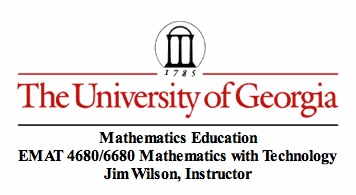
An
Exploration of the Angle Bisectors of an Acute Triangle
By: Sydney
Roberts
Consider any
acute triangle ABC and its circumcircle.

Now consider
the angle bisector of each angle within the triangle, and label the points
where these bisectors will intersect the circumcircle as points L, M, and N
respectively.

Now we want
to find angles L, M, and N in terms of the angles A, B, and C. However, notice
that all of the angles (A, B, C, L, M, and N) are inscribed angles. Hence, the
inscribed angle theorem holds which says that the measure of the intercepted
arc is exactly twice of the measure of the inscribed angle. A consequence of
this is that the property holds for all inscribed angles of an intercepted arc.
For example, the measure of arc BC is the same as twice the measure of ![]() †and
†and ![]() .
.
Therefore, to find
angles L, M, and N in terms of A, B, and C we will use this fact. Start by
considering angle L and arc AM. Notice that since ray
M is the angle bisector for angle B, then ![]() . However, note that arc AM also has
another inscribed angle,
. However, note that arc AM also has
another inscribed angle, ![]() . Hence, because of the previously stated
theorem,
. Hence, because of the previously stated
theorem, ![]() . Hence,
. Hence, ![]() .
.

Now, since ray CN is the angle bisector of angle C, then ![]() †
†![]() †has an intercepted arc AN which has another
inscribed angle,
†has an intercepted arc AN which has another
inscribed angle, ![]() . Hence,
. Hence, ![]() .
.

And therefore, ![]() . Hence, we have described angle L in
terms of angles A, B, and C as desired. Now, letís do the same for angle M.
. Hence, we have described angle L in
terms of angles A, B, and C as desired. Now, letís do the same for angle M.
Start by considering ![]() and arc BL. Since ray AL is the angle
bisector of angle A, then we know
and arc BL. Since ray AL is the angle
bisector of angle A, then we know ![]() . The intercepted arc here is arc BL, so
we also know that
. The intercepted arc here is arc BL, so
we also know that ![]() †is
half the measure of the intercepted arc. Again, there is another intercepted
arc to consider and that is
†is
half the measure of the intercepted arc. Again, there is another intercepted
arc to consider and that is ![]() †Hence,
†Hence, ![]() .
.

Now consider ![]() and intercepted arc NB. Since ray CN is
the angle bisector of angle C, we know that
and intercepted arc NB. Since ray CN is
the angle bisector of angle C, we know that ![]() †which is also equivalent to Ĺ the measure of
the intercepted arc NB. Therefore, we can look for other inscribed angles that
intercept the same arc and we see that
†which is also equivalent to Ĺ the measure of
the intercepted arc NB. Therefore, we can look for other inscribed angles that
intercept the same arc and we see that ![]() †does. Therefore,
†does. Therefore, ![]()

Therefore, ![]() †which is in terms of our original angles, as desired.
†which is in terms of our original angles, as desired.
Finally, we can do the same thing for angle N and we see that since
ray AL is the angle bisector of angle A, then ![]() . Now considering the intercepting arc
LC, we see that
. Now considering the intercepting arc
LC, we see that ![]() †is
also the same as
†is
also the same as ![]() . Hence,
. Hence, ![]() .
.

Now consider ![]() . Since ray BM is the angle bisector of
angle B, then †
. Since ray BM is the angle bisector of
angle B, then †![]() †which
is also half of the measure of the intercepted arc CM. However, this arc has another
inscribed angle,
†which
is also half of the measure of the intercepted arc CM. However, this arc has another
inscribed angle, ![]() †Therefore,
†Therefore, ![]() .
.

Hence, ![]() . In conclusion we can define angles L,
M, and N in terms of A, B and C since
. In conclusion we can define angles L,
M, and N in terms of A, B and C since



To determine whether or not you think these defintions only hold for acute triangles, use the following GSP file to make your own conjectures.
Hopefully you can conclude that this will always hold since our definitions are made by using arbitrary arc and angle measures.